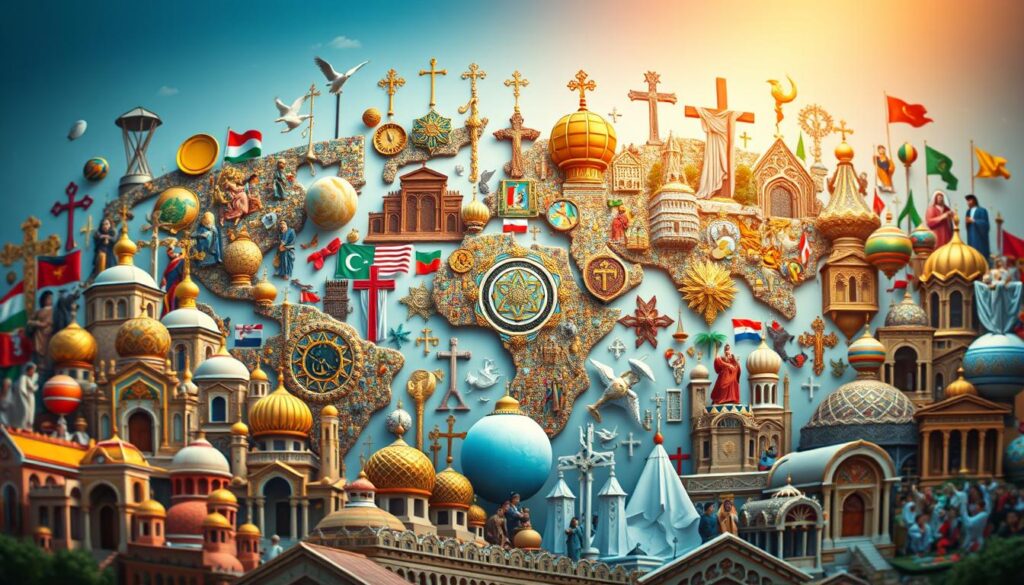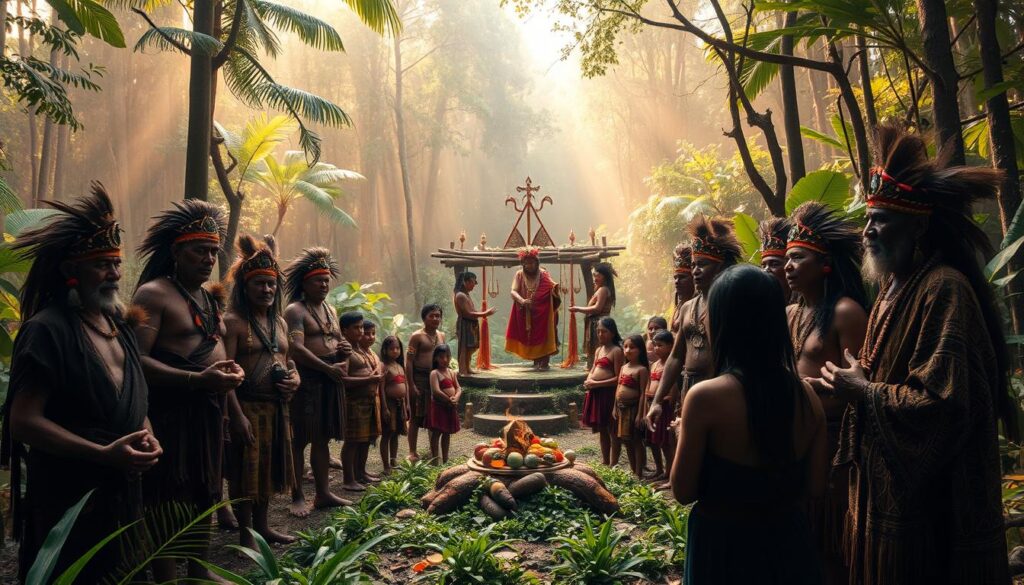Have you ever thought about the importance of understanding global religious diversity? It’s fascinating to learn about the many types of religion in our world today. As we explore, we see the complexity and richness of human faith.
Exploring the Different Types of Religion Worldwide
The question that sparks our curiosity is, what are the various faiths that make up our global religious diversity? And how do they impact our lives, How Many Types of Religion in the World Today.

As we explore the different types of religion in the world, we discover the importance of understanding and respecting diverse faiths. This journey will take us through various religions, from the well-known to the lesser-known. We’ll gain insight into the significance of global religious diversity.
Key Takeaways
- Understanding global religious diversity is essential in today’s world.
- There are numerous types of religion in the world, each with its unique beliefs and practices.
- Different religions worldwide have shaped human history and culture.
- Global religious diversity promotes tolerance, acceptance, and cooperation.
- Exploring the various faiths that exist around the world can enrich our lives and broaden our perspectives.
- Respecting and appreciating the diversity of religions is crucial for building a harmonious global community.
- Learning about the different types of religion in the world can help us better understand ourselves and others.
Understanding Religious Diversity in Our Modern World
We live in a world where major world religions coexist, each with its own beliefs and practices. It’s important to recognize the diverse religious traditions found globally. From Abrahamic religions to Dharmic and East Asian traditions, the variety of religious beliefs around the globe is vast and interesting.
Religion plays a big role in shaping culture, politics, and individual lives. The influence of major world religions on society is wide-ranging. It affects art, literature, law, and governance. By looking at religious demographics in different areas, we can better understand the ties between faith, culture, and identity.
- Coexistence of different faiths in the same region
- Influence of religion on cultural and social norms
- Role of religion in shaping individual and collective identities
Defining Religion and Faith
Exploring the concept of religion, it’s key to define faith and its connection to religious beliefs around the globe. By grasping the differences in diverse religious traditions, we can build more empathy and tolerance in our connected world.
How Many Types of Religion in the World Today
Many of us wonder about the number of religions in the world. The answer is not simple. It depends on how we define a religion. Major world religions like Christianity, Islam, Hinduism, Buddhism, and Judaism are well-known and practiced globally. But, there are also many indigenous faiths, folk religions, and new religious movements that are less known but important.
Looking at the global religious scene, we see that different places have their own religions. For example, Asia has Buddhism, Hinduism, and Islam. In contrast, Africa is rich in indigenous faiths and folk religions. The spread and change of religions around the world are influenced by many factors.

- There are about 4,200 to 4,300 recognized religions worldwide.
- These can be grouped into major categories like Abrahamic, Dharmic, and indigenous faiths.
- The way religions spread and change is influenced by migration, conversion, and cultural exchange.
Exploring the number of religions in the world is complex. We must look at the different types of religions and where they are found. This helps us understand the diverse faiths that make up our world today.
Major World Religions and Their Branches
We look into the major world religions, their history, beliefs, and practices. This helps us understand the various faiths globally and their impact. These religions have been key in shaping human society, influencing cultures, and daily life.
Exploring the major world religions, we see they fall into several groups. These include:
- Abrahamic religions, like Christianity, Islam, and Judaism, which share a common ancestor, Abraham.
- Dharmic religions, including Hinduism, Buddhism, and Sikhism, which come from India and focus on dharma, or duty.
- East Asian religious traditions, such as Confucianism and Taoism, which have shaped China and other parts of Asia.
These major world religions have many branches and denominations, each with its own traits and practices. By understanding and respecting these differences, we can promote greater tolerance and appreciation for the diverse faiths globally. This helps us see their role in shaping worldwide religious practices.
As we dive deeper into the complexities of major world religions, we gain a deeper understanding of their importance in today’s society. We see their impact on worldwide religious practices.
| Religion | Number of Adherents | Main Practices |
|---|---|---|
| Christianity | 2.4 billion | Prayer, attending church services |
| Islam | 1.8 billion | Five daily prayers, fasting during Ramadan |
| Hinduism | 1.2 billion | Yoga, meditation, worship of deities |
Indigenous and Traditional Religious Practices
We understand the value of keeping and honoring indigenous and traditional faiths. They are a key part of the diverse religious traditions across the globe. These beliefs are deeply rooted in the culture and spirituality of their communities.
Studies on these faiths highlight their crucial role in the global religious distribution. Many of these practices are found in specific areas and communities. For instance:
- Native American religions, like Shamanism and Animism, are found in North America.
- African traditional religions, such as Yoruba and Vodun, are common in West Africa and the Caribbean.
- Indigenous Australian religions, including Dreamtime, are practiced in Australia.
These faiths are vital to the communities that follow them. They also add to the rich variety of diverse religious traditions worldwide. By learning about and valuing these faiths, we can better appreciate the global religious distribution. We also see the many ways people express their spirituality.

As we dive deeper into indigenous and traditional religious practices, we see their importance. We must preserve and respect these faiths. They enrich our understanding of the global religious distribution.
| Region | Indigenous Faiths |
|---|---|
| North America | Shamanism, Animism |
| West Africa | Yoruba, Vodun |
| Australia | Dreamtime |
New Religious Movements and Modern Spirituality
We’re seeing a big increase in new religious movements and modern spirituality. This shows the wide variety of various faiths globally. These movements are influenced by worldwide religious practices and add to the rich mix of global religious diversity.
Some notable examples of contemporary spiritual movements include:
- Eclectic spirituality, which combines elements from different traditions
- New Age movements, focusing on personal growth and self-awareness
- Neo-paganism, emphasizing a connection with nature and the environment
Contemporary Spiritual Movements
These movements mix old beliefs with new practices, creating unique spiritual scenes. By looking into these movements, we can understand the complex nature of global religious diversity better.
Syncretic Religious Traditions
Syncretic religious traditions, which mix elements from several faiths, are also growing. These traditions show how worldwide religious practices are shaping our global spiritual scene.
| Tradition | Description |
|---|---|
| Buddhist-Christian dialogue | A synthesis of Buddhist and Christian teachings |
| Islamic-Sufi traditions | A blend of Islamic and Sufi mystical practices |
| Indigenous spiritualities | A revival of native spiritual practices and traditions |
Geographic Distribution of Religious Traditions
The world is filled with many faiths and practices. Each region shows its own unique mix of religions, shaped by culture and history. Looking at where religions are found, we see different continents have their own religious profiles.
Human spirituality is complex and rich, with many traditions around the globe. The Middle East has Abrahamic religions, while Asia is home to Dharmic ones. Migration, colonialism, and globalization have spread religions far and wide.
Religious Demographics by Continent
- Asia is home to a large percentage of the world’s Buddhist and Hindu population.
- Africa has a significant number of Muslims and Christians, with many indigenous religious traditions also present.
- Europe is predominantly Christian, with a growing number of Muslims and other religious minorities.
Knowing where religions are most common helps us understand the world better. By looking at the variety of traditions and practices, we learn more about human spirituality. We see how faith influences our lives and communities.

The Evolution of Religious Beliefs Through History
Exploring the history of major world religions shows us how beliefs have changed over time. Many factors, like culture, society, and geography, have played a role. We see more types of religion in the world today, with new ones starting and old ones splitting into different groups.
Several key factors have shaped the evolution of religious beliefs:
- Geographical migration and cultural exchange
- Philosophical and theological debates
- Historical events and social movements
The spread of major world religions like Christianity, Islam, and Buddhism is linked to people moving and sharing ideas. New religious movements and changes in old ones have been influenced by debates and historical events.
It’s crucial to understand how religious beliefs have evolved to appreciate today’s types of religion in the world. By looking at the history and development of major world religions, we can better understand human faith and spirituality.
As we dive deeper into the evolution of religious beliefs, we see that the number of types of religion in the world keeps growing. This shows how vital it is to respect and understand the diversity of major world religions and their impact on culture and society.
| Religion | Origin | Key Figures |
|---|---|---|
| Christianity | 1st century AD | Jesus Christ, Saint Paul |
| Islam | 7th century AD | Muhammad, Abu Bakr |
| Buddhism | 6th century BC | Siddhartha Gautama, Mahavira |
Common Elements Across World Religions
Exploring global religious diversity shows us that many faiths share common elements. Despite their differences, religions often agree on moral values like compassion and respect for life. These values are seen in the teachings of Buddhism, Christianity, and Islam.
Looking at various faiths, we find many similar practices. For example, prayer, meditation, and fasting are common. These shared practices show that humans, regardless of religion, share common needs and experiences. Understanding these similarities helps us respect and tolerate different religions.

Also, sacred texts from different religions often share similar messages. The Bible, the Quran, and the Torah all teach about love, forgiveness, and selflessness. By studying these texts, we can see the commonalities in worldwide religious practices.
- Shared moral values, such as compassion and kindness
- Similar religious practices and rituals, like prayer and meditation
- Sacred texts and teachings that convey messages of love and forgiveness
By recognizing these common elements, we can build a more harmonious world. A world where global religious diversity is celebrated and respected.
Impact of Globalization on Religious Diversity
We live in a world where globalization has brought people together. This has changed the global religious distribution a lot. People moving to new countries share their worldwide religious practices, making faiths more diverse.
Globalization affects diverse religious traditions in many ways. It brings new ideas and faiths but also erodes old practices. To grasp its impact, we must look at migration, global connections, and how faiths evolve.
- Migration and demographic changes
- Global connectivity and the spread of ideas
- The evolution of worldwide religious practices and traditions
As we move through this changing world, we must be respectful and open. Embracing our differences helps create a more inclusive place.

To show how globalization affects diverse religious traditions, let’s look at a table:
| Region | Traditional Religion | Emerging Faiths |
|---|---|---|
| Asia | Buddhism, Hinduism | Christianity, Islam |
| Europe | Christianity | Islam, Buddhism |
| Africa | Traditional African Religions | Christianity, Islam |
This table shows the complex nature of global religious distribution. It emphasizes the need for ongoing research into globalization’s effects on faiths.
Conclusion: Understanding and Respecting Religious Plurality
Our world is filled with many faiths and beliefs. From old Abrahamic and Dharmic traditions to new new religious movements, the variety is amazing. It shows how many types of religion exist.
Accepting this religious plurality is key to peace and understanding. It’s about respecting each faith tradition and its unique views. This way, we learn from each other and find common values.
Let’s work towards being champions of religious tolerance. Seeing the diversity of various faiths globally as a strength is important. By valuing the differences in beliefs, we can build a more united and diverse society.
FAQ
How many types of religion are there in the world?
There are many religious traditions and faiths worldwide. Estimates range from hundreds to over 4,000. This shows the rich diversity of human beliefs and cultures.
What are the major world religions?
Major world religions include Hinduism, Buddhism, Judaism, Christianity, and Islam. These faiths have the most followers and have shaped human history.
What is the role of religion in human society?
Religion is key in shaping societies. It offers guidance, community, and meaning to millions. It influences culture, politics, and individual lives, helping us understand the world and our place in it.
What are some examples of indigenous and traditional religious practices?
Indigenous and traditional religions vary across cultures. Examples include shamanism in Siberia, Vodou in Haiti, Shinto in Japan, and Santería in the Caribbean. These faiths are deeply rooted in local communities and the natural environment.
What are some new religious movements and modern spiritual traditions?
New religious movements and modern spiritual traditions have emerged. Examples include Scientology, Wicca, and New Age spirituality. These faiths mix elements from various religions and cultures, showing spiritual evolution.
How has globalization impacted religious diversity?
Globalization has both helped and hindered religious diversity. It has spread different faiths worldwide, leading to more religious pluralism. Yet, it has also caused cultural clashes and threatened traditional practices in some areas.

